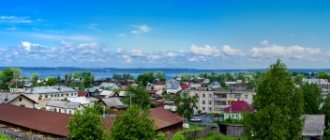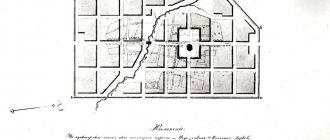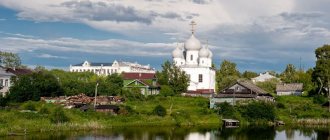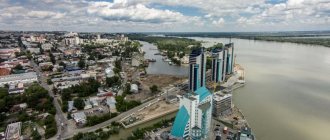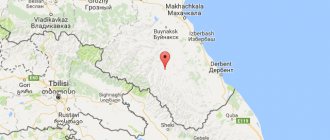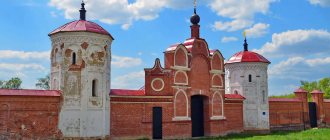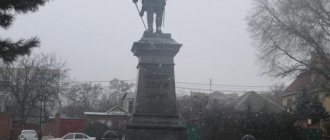Photo: wikipedia.org
Vologda is an ancient city in northern Russia and is the administrative, industrial and cultural center of the Vologda region. Located at the intersection of major transport routes: highways and the Northern Railway. The population is 308,530 people. The area of the city is 116 square meters. km.
Vologda is territorially divided into two administrative units - the Vologda city district and the village of Molochny. There is no official division of the city district, but conditionally it is still divided into districts. Next, let's look at the features of each of them.
Zarechye
Photo: Yandex map
Located across the Vologda River, on the left bank. A characteristic feature of the area is the proximity of old and modern buildings. Individual construction is developing on the outskirts of Zarechye. City transport is represented by buses and trolleybuses. There is an abundance of shops in the area - both large chain stores and small retail outlets. The infrastructure is developed, everything is within walking distance: a school, a kindergarten, and a hospital. There is one secondary vocational educational institution in Zarechye.
There are many churches in this area, for example, the Presentation of the Lord, St. George's on Navoloka, and the Skulyabinsk almshouse. There is a Veterans Park. There are no hotels. According to reviews from city residents, the rent and cost of housing are the same as in the center.
Routes on the map of Vologda. Transport infrastructure
Vologda is a major transport hub in Russia, as can be seen on the map at the numerous intersections of federal highways:
- The M8 Kholmogory connects Moscow, Yaroslavl and Arkhangelsk;
- A114 “Vologda - Novaya Ladoga” runs from Vologda through Cherepovets to St. Petersburg;
- A119 “Vologda - Medvezhyegorsk” goes from Vologda to Vytegra, Petrozavodsk and Murmansk.
The map clearly shows an extensive web of regional roads connecting all the major regional centers of the region. bus station is located next to the railway station on the square. Babushkina regional center.
through the railway junction every day, this is the highest freight intensity in Russia. Currently, construction of a bypass railway around Vologda is underway.
The Transsib railway passes through the Vologda-1 station Trains traveling to the north of the country from Moscow to Arkhangelsk, Murmansk, Vorkuta, Severodvinsk make stops in Vologda. In total, more than 27 long-distance trains and commuter trains depart from the railway station every day.
The previously navigable Vologda River, having become shallow, lost its transport significance.
From the Vologda airport there are flights to Moscow (Vnukovo) and Veliky Ustyug.
Public transport within the city is represented by buses, commercial buses, trolleybuses and minibuses. The wear and tear of rolling stock is quite high; some minibuses and commercial vehicles duplicate municipal transport routes and delay passenger traffic. The advantage of urban transport is the availability of comfortable, large-capacity buses, 160 in total. 50 bus routes and 3 trolleybus routes cover all areas of the regional center.
Watermen
Photo: Yandex map
Located on the left bank of the Vologda River. The area is considered old, although the construction of housing and social facilities was carried out intensively in the 80s of the last century. Then, with the collapse of the USSR, it stopped and resumed only in 2000. The development took place on a site adjacent to Severnaya Street. Currently, the construction of 9- and 12-story apartment buildings is underway.
The infrastructure of the area is developed. There are educational institutions, kindergartens, shops of various types, cafes and bars. There are many companies providing household services, car repair services and many other organizations and enterprises necessary for a normal life. Among the attractions are the Church of St. Andrew the First-Called and the house of the poet Nikolai Rubtsov. The area is ideal for short-term rental housing for tourists and business travelers.
Flax mill
Photo: Yandex map
Located on the right bank of the Vologda River, it occupies the south-eastern part of the city. Conditionally limited by Kozlenskaya, Petrozavodskaya, Marshal Konev and Moskovskaya streets. A railway with a station of the same name runs through the area. The housing stock is represented mainly by two-story houses. Their distinctive feature is the presence of balconies, terraces, and mezzanines. Modern construction of high-rise buildings is also underway. The Church of St. Sergius of Radonezh is an ancient monument. The cost of housing in this area is high - at the same level as the city center.
Crime
Is life without crime conceivable? Without visible - obviously, yes. One can even remember that the notorious “dashing 90s” passed through Vologda in a very tangential way. It is no coincidence that even then the city did not endow the country with ANY significant criminal authority. The explanation is simple: a lot in the region is connected with units of the Northern Sea Fleet, aviation and strategic missile forces. Many military towns and villages are still classified.
In addition, the penitentiary system is very powerful here. An eloquent example: the well-known “zero kilometer” is located in Vologda. This is the starting point on the way to the most important financial and economic centers of the North-West.
Zero kilometer
As a result, it is quite appropriate to say that the Vologda law enforcement agencies are controlling the situation. However, it is possible that crime has been legalized. Or he went underground. Options are possible. But they remain only assumptions. The problem of nationalism does not arise here either - Vologda is practically mono-ethnic, 97% of the population is Russian.
Byvalovo
Photo: Yandex map
It got its name from the village of the same name, located on this site. It occupies the southern part of Vologda, from the railway station along Poshekhonskoye Highway on both sides. This is a relatively young area. The construction of 9- and 12-story apartment buildings began in 1982 and is still ongoing.
On the territory of the district, in its southern part, there are buildings of the regional hospital. The Byvalovsky Machine-Building Plant, the Vologda Dairy Plant and the Agricultural Greenhouse are located here. The infrastructure of the area is developed. There are various organizations and institutions, two secondary schools, kindergartens, hotels, canteens, cafes, restaurants, shops. City transport is represented by buses and trolleybuses. Tourists and business travelers can find daily rental housing.
Enterprises and work in Vologda
Let's consider the most promising (locally) employment options. JSC Vologda Bearing Plant is the largest manufacturer (more than 18% of total production) of bearings in Russia. The product is a hot commodity, a product in demand, there are no plans to reduce demand for it in the coming years, which means production should not suffer. However, against the background of the general decline in production in Russia (as well as internal problems), salaries at the plant are not too high, and there are not a lot of jobs.
Vologda Bearing Plant
Next is Elektrotekhmash OJSC, the production of oil radiators and pumps, products that are not as popular as bearings, but nevertheless quite popular. On the basis of Elektrotekhmash, Vologda Pipe Rolling Plant LLC was created, which, oddly enough, produces pipes. Both enterprises belong to the same management company and deserve attention as potential employers.
OJSC “Vologda Optical-Mechanical Plant” is one of the few enterprises of the former defense industry that, after its collapse, managed not only to survive, but also to remain a competitive enterprise. It is still assembling its direct products (sights) and mastering the production of simple electronic devices (complex ones, of course, will clearly be inferior to foreign analogues in our market). At the time of writing, they were even recruiting staff in connection with the expansion, which is already saying something.
Vologda Optical-Mechanical Plant
The former giant of the textile industry, Vologda Flax Mill, unlike Optics, did not survive the 90s. The military began to order fewer trucks, and they no longer needed tarpaulins... although this is only a fraction of the plant’s problems. As a result of long agony and disgusting management, from a leader in the production of flax products in Russia, the plant has slipped into an outsider even by the standards of the Vologda region, and its future does not inspire hope.
It makes sense to get a job at one of the enterprises associated with the railway (or directly there, if possible): the car repair plant or the Byvalovo Machine Plant (production of gantry and tower cranes), or with the forestry industry: Vologdalestopprom, Vologda Timber Industry, LPK Kipelovo or Soyuzlesmontazh.
The city also has a large food industry sector, well-known dairy production (Vologda Dairy Plant, Vologda Ice Cream) and the production of alcoholic beverages (Variety Vodka Factory). Separately, I would like to note the former workers’ settlement, and now (since 2004) the village of Molochnoye, located 7 km away. from the city limits of Vologda. With a population of 7 thousand people, it can safely be called “Skolkovo of the Russian agricultural industry”: in the village there are 3 agricultural universities, a training and experimental plant and a main center of agrochemical service.
The average salary in Vologda, according to the penultimate data, is 18,000, the latest – 27,000 rubles per month. It is curious that in the fall of 2011 the figure was 20,000. Such jumps can only be logically explained by the fact that the figure “27” is taken for the region as a whole. At the Cherepovets Metallurgical Plant they really earn extremely well - up to 50,000 per month. If you believe the “wanted” advertisements in Vologda, work is extremely rarely paid in excess of 20,000 rubles. More often it is appropriate to talk about 15 - 17,000. At the same time, the pearl of the North is a fairly expensive city to live in by the standards of an average Russian city. Fare - 16, bread - 25, sausage - from 100 rubles.
Center
Photo: Yandex map
This is the historical part of Vologda. Is a tourist center. The Vologda Museum-Reserve and the Vologda Kremlin are located here. Many buildings from the 19th and 20th centuries have been preserved: mostly wooden mansions with architectural features of that time.
A lot of “compensatory” development is an imitation of traditional Vologda wooden houses in order to preserve the historical appearance of Vologda. Along with ancient buildings, there are standard multi-storey buildings built in the 60-80s. There are many shops, shopping and entertainment centers and catering establishments in the center. Higher and secondary educational institutions and offices of regional structures are concentrated here. There are parks with places of recreation and entertainment, children's playgrounds.
The price of real estate is high: the cost of renting housing starts from 450 rubles per day, a one-room apartment starts from 1.7 million rubles (according to data taken from open sources). This is a clean and well-maintained area.
General information and history of Vologda
According to official data, in 1147 the monk Gerasim crossed the Vologda River and founded the Trinity Monastery near the Kaysarov stream. In turn, the city came from the monastery. “Tales of the Miracles of Gerasim of Vologda” and “The Chronicler” by Ivan Slobodsky speak about this. Data from archaeological excavations reveal the first signs of the existence of the settlement a little later - in the 13th century. Vologda was first mentioned in writing in 1264 - as a peripheral possession of Veliky Novgorod (agreement with the Grand Duke).
Autumn Vologda
In those days, Vologda was a small settlement with a population of 1 (XV century) to 4 (XVIII century) thousand people. At the same time, due to the peculiarities of its geographical location - the center of the North-Western region, the center of the trade route between Russia and the Scandinavian countries, in the border with Poland, the city steadily became a powerful cultural center. Significant architectural monuments appeared at the turn of the 15th and 16th centuries. In particular, in 1567 the Vologda Kremlin, also known as the City and Nason-gorod, was built.
Vologda Kremlin and St. Sophia Cathedral
Until the 19th century, Vologda remained a small town on the river of the same name with a population of no more than 10 thousand people, mainly engaged in agriculture, fishing and trade. Politically, at first it walked under the hand of Novgorod (then still the Great), then it remained independent for a short time, and then it was swept up by the expanding Muscovy.
Unlike many Russian cities, it safely escaped the Tatar-Mongol yoke, but in the troubled times of False Dmitry, the Poles got here and thoroughly plundered and destroyed the city, so that there are not enough historical values older than 1612 left today.
Vologda was the main transit point in trade with Denmark and England; Peter I further strengthened its importance by building a large military base and shipbuilding workshops there. But, as often happens, he also destroyed this meaning by building St. Petersburg, which became a new “window to Europe.” Vologda quickly fell into disrepair and began to develop again only with the construction of a railway line to St. Petersburg and the advent of Soviet power.
Lactic
Photo: Yandex map
Located 7 km from Vologda. It is considered a major research and training center in the agricultural field. It is a cultural heritage of the Russian Federation. There is a higher educational institution - VSMHA named after. N.V. Vereshchagina, research institutes. Students undergo practical training in the educational and experimental dairy plant at the Academy. Bus service has been established on two routes. There are no ancient monuments, the area is relatively young. Real estate prices are lower than in the city center.
Population of Vologda
Vologda is a very young and, one might say, mono-ethnic city. According to data at the beginning of 2014, 308 thousand people permanently reside here. Including men - 44.2%, women - 55.8% of the total population. The absolute dominant group is working age - 65.7%, younger - 15.3%, older - 19% of the total number. Interestingly, 50,000, or every sixth Vologda resident, are classified as “officials”. There is no such concentration of administrative workers in any other city in the Russian Federation.
In the national division, Russians more than prevail - 96.5%. In 2nd place are Ukrainians - 1.4%, in 3rd place are Belarusians - 0.6%. Tatars, Gypsies, Moldovans, Chuvashs and Azerbaijanis are included in the “other nationalities” column.
For comparison: from the beginning of the 18th to the end of the 20th century, the population of Vologda developed dynamically - from 4,100 people according to the Census of 1712 to 306,000 according to the results of 1988. With the collapse of the Union there came a certain decline. Now it has been partially overcome. Scientists are not inclined to idealize the situation and associate it with ongoing urbanization. Simply put, rural residents of working age en masse move to the regional center for a better life.
However, the factor of fertility, which took place at the end of the USSR, in 1988-1991, is not denied. It is still visible today. More children were born last year than the year before, which, in turn, was slightly ahead of 2009. So far, these numbers are not so significant to draw at least some conclusions from them.
